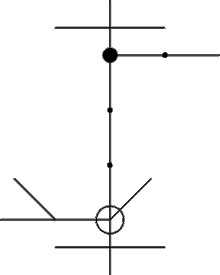Main article: Karate kata
Kata is often described as a set sequence of karate moves organised into a pre-arranged fight against imaginary opponents. The kata consists of kicks, punches, sweeps, strikes and blocks. Body movement in various kata includes stepping, twisting, turning, dropping to the ground, and jumping. In Shotokan, kata is a performance or a demonstration, with every technique potentially a killing blow (ikken hisatsu)—while paying particular attention to form and timing (rhythm). As the karateka grows older, more emphasis is placed on the health benefits of practicing kata, promoting fitness while keeping the body soft, supple, and agile.
Several Shotokan groups have introduced kata from other styles into their training. The original Shotokan kata syllabus is introduced in Funakoshi's book Karate-do Kyohan, which is the Master Text of Shotokan karate. Dai Nihon Karate-do Shotokai is the official representative of Shotokan karate. Japan Shotokai's kata syllabus is the same as established in "Karate-do Kyohan" added Gigo Funakoshi's staff kata Matsukaze No Kon.[10] When the JKA was formed, Nakayama laid down 27 kata as the kata syllabus for this organisation. Even today, thousands of Shotokan dojo only practice 26 of these 27 kata. The standard JKA kata are: Taikyoku shodan(sometimes termed Kata Kihon or Kihon Kata, the name has been discontinued in some Shotokan dojos) (太極初段), Heian shodan (平安初段), Heian nidan (平安二段), Heian sandan (平安三段), Heian yondan (平安四段), Heian godan (平安五段), Bassai dai (披塞大), Jion (慈恩), Enpi (燕飛), Kanku dai (観空大), Hangetsu (半月), Jitte (十手), Gankaku (岩鶴), Tekki shodan (鉄騎初段), Tekki nidan (鉄騎二段),Tekki sandan (鉄騎三段), Nijūshiho (二十四步), Chinte (珍手), Sōchin (壯鎭), Meikyō/Rōhai (明鏡), Unsu (雲手), Bassai shō (披塞小),Kankū shō (観空小), Wankan (王冠), Gojūshiho shō (五十四歩小), Gojūshiho dai (五十四歩大), and Ji'in (慈陰)


No comments:
Post a Comment